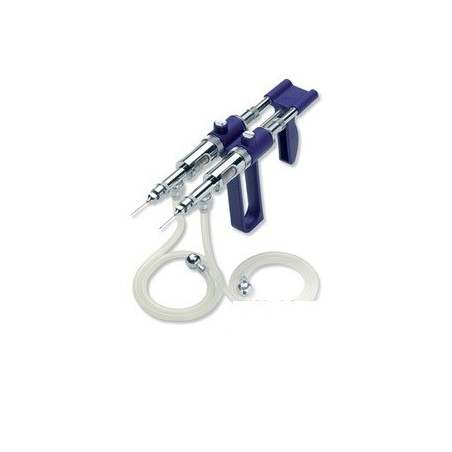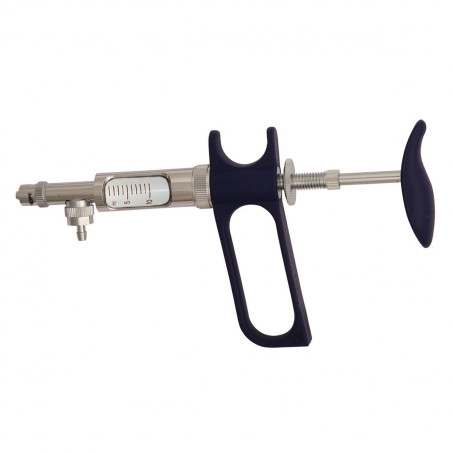|
Dr. Robert Morrison was a swine veterinarian and a professor of the University of Minnesota (UMN) College of Veterinary Medicine. His main task at the college was conducting research and teaching swine health and production. He was also a well-known researcher, mentor of a number of graduate students and a very active person within the swine industry. Dr. Morrison was a firm believer of doing applied and relevant research as well as having a cooperative approach. Under those premises, Dr. Robert Morrison created the Swine Health Monitoring Project (SHMP) in 2011. According to Dr. Morrison, the inception of the project was during the NA-PRRS symposium in Chicago. He proposed that veterinarians from each production companies shared their PRRS sow herd breaks to build a frequency table the incidence and prevalence of PRRS in the industry. That same Friday, the first report of this collaborative effort was created and was the seed of what today is the SHMP was issued. Ever since, that weekly report has been consistently issued and has become an important reference for the current PRRS situation in the US.  After Dr. Morrison’s tragic loss in May 2017 the program was renamed. Today the project is known as the Morrison Swine Health Monitoring Project (MSHMP). Recently, Dr. Cesar Corzo, the new Leman Chair of the UMN was appointed as the leader of the project. |
The project goals
The MSHMP is a voluntary program led by the UMN and funded by the Swine Health Information Center where veterinarians and producers share the sow farm health status. The program focuses mainly in two diseases: Porcine Reproductive and Respiratory Syndrome (PRRS) and Porcine Epidemic Diarrhea (PED). However, the project also gathers diagnostic data from 4 Veterinary Diagnostic Laboratories (Iowa, Kansas, Minnesota and South Dakota) on US industry relevant diseases such as: Senecavirus A and central nervous systems related diseases. The project currently involves 22 companies, 5 veterinary clinics and 4 area regional control programs that all together represent approximately 3,000,000 sows which is approximately 50% of the US sow population of the US according to the USDA census. All these participants are willing to share their data for the greater good.
The MSHMP has two main objectives, a short and a long term goal. The long term goal of this project is to prepare the swine industry to respond in case a foreign animal disease (FAD) or an emerging pathogen is introduced. This long-term goal focuses in providing the necessary tools to the industry to respond in a timely manner should a new disease enters the country. These tools include methods to trace animal movement, data visualization, modeling of disease spread. All these would not be effective if there is not active communication; therefore, to promote voluntary and valuable participation, the project has a secondary goal focusing on delivering short-term value through different projects with participants. For instance, helping producers and veterinarians with outbreak investigations, PRRS sequence analysis to detect emerging strains and the weekly report summarizing key findings from data being collected are some examples.
The weekly report is one of the important short-term outcomes of the MSHMP where both incidence and prevalence of two main diseases PRRS and PED is monitored for the current fiscal year and compared to previous years. For PRRS, veterinarians and producers report sow herd change in status in a weekly basis and a number of those systems follow the AASV guidelines for status classification (Holtkamp, 2013). Briefly, classification goes from 1 to 4, being 1) a positive unstable herd that is actively shedding, 2) positive stable indicating that due-to-wean piglets have yielded 4 consecutive negative PCR test results during 90 days, 3) provisionally negative, which are those herds that are weaning negative piglets and the replacement gilts that have entered the herd remain seronegative and 4 for herds that have rolled over and there are no remaining sows that had been exposed to the virus. Within category 2, there are 2 sub-categories which are related to herds that will continue to expose their incoming gilts either by vaccinating (2vx) or by live-virus inoculation (2fvi). In the case of PEDv, veterinarians and producers also classify farms for PED following a similar manner.
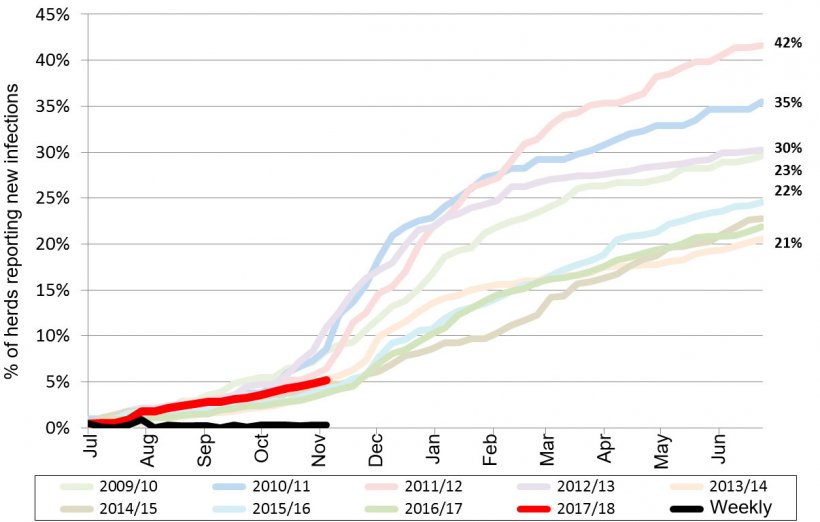
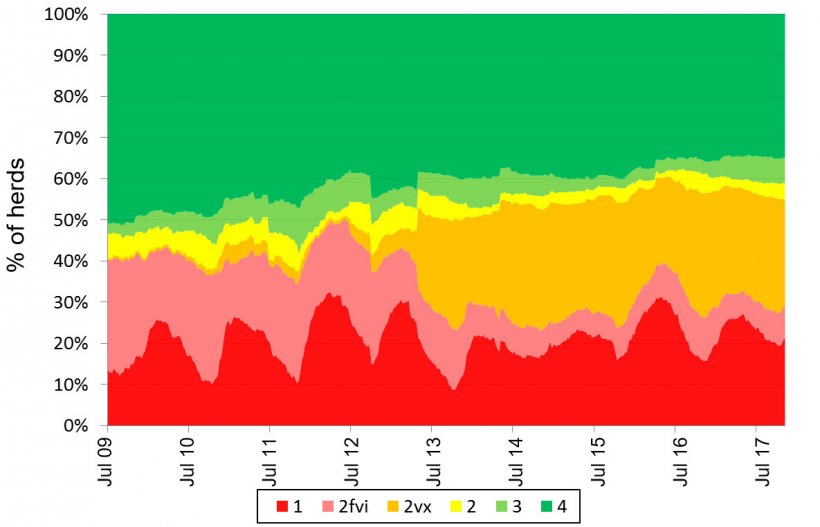
What is the value of the MSHMP for the producer?
Besides the before mentioned main goals of the MSHMP project, there are other unique characteristics that makes it a useful tool for producers and swine industry in general. For instance, a rich database that provides a resource to enable regional outbreak investigations or other system specific investigations that otherwise would not take place. That data allows researcher to offer preliminary data to guide future studies or areas of control for the industry. Another example is guiding the industry regarding to when biosecurity measures should be tightened to be prepared to prevent PRRS, e.g. the high risk PRRS season. Figure 3 depicts the repeatable pattern of PRRS in the US industry (Tousignant, 2015).
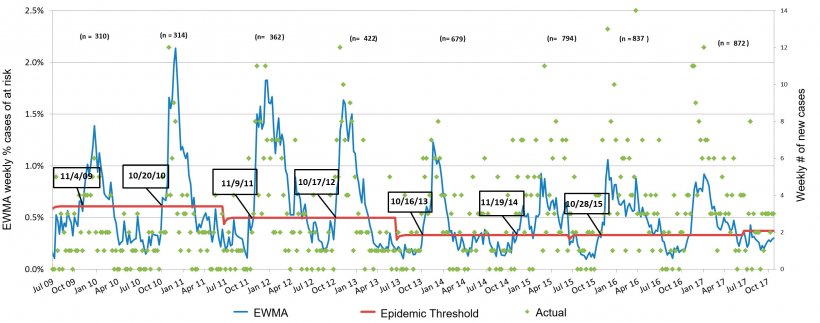
The MSHMP provides the opportunity from the industry to give an answer against foreign pathogens or emerging disease, e.g. the MSHMP played an important role during the PED outbreak in the US by communicating with different participants or facilitating the exchange of information available.

Also the project is related to other projects that involve the sharing of other databases and information. That synergy helps the project to be able to offer even more resources to producers and veterinarians and help them understand the epidemiological features of a disease, how to perform surveillance and make decisions from a preventive measures standpoint.
Conclusion
All in all, the MSHMP is a unique voluntary program where a dataset is built thanks to producers and veterinarians willingness to share data. The project has proved to be very valuable for the industry since its creation in 2011 and since then the number of participants doubled. However, the project is always looking forward to extract more value to provide the swine industry with useful information and newer tools that will help in the future to manage future threats.





